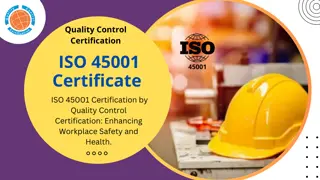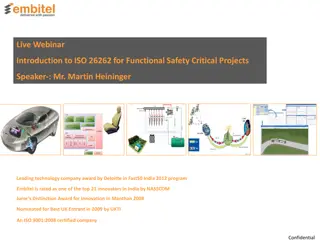Understanding ISO 9000 and ISO 14000 Standards at Idhaya College for Women, Kumbakonam
Explore the significance of ISO 9000 and ISO 14000 standards in quality management, their processes, benefits, and updates. Dr. Chitra Isac explains the need for these standards, documentation requirements, and their impact on organizations. Delve into the history, revisions, and goals of ISO 9000:2000, emphasizing the connection to business processes.
Download Presentation

Please find below an Image/Link to download the presentation.
The content on the website is provided AS IS for your information and personal use only. It may not be sold, licensed, or shared on other websites without obtaining consent from the author. Download presentation by click this link. If you encounter any issues during the download, it is possible that the publisher has removed the file from their server.
E N D
Presentation Transcript
IDHAYA COLLEGE FOR WOMEN, KUMBAKONAM Semester: Subject: Subject Code: Unit: Class: Topic: IV Total Quality Management P16MBA18 V II MBA 1. ISO 9000 2. ISO 14000 Dr. Chitra Isac M.B.A., M. Phil., S.E.T., Ph. D., Head- Department of Management Idhaya College for Women, Kumbakonam Faculty Name: 1 1
Content Need for ISO 9000- ISO 9000-2000 , Process of obtaining ISO Certification, Advantages of ISO certification, New version of ISO standards Documentation, ISO 14000 Concepts, Requirements and Benefits 2
Objective & Learning Outcome Objective: To understand the statutory and regulatory requirement of quality management LearningOutcome: To have understood the need, importance and process of applying of qualty standards through ISO Series Takeaways: Quality standard Institutions in India 3
The ISO 9000 SERIES What? Set of international standards Quality Management+ Quality Assurance Effectively Document The Quality System Why? To maintain an efficient quality system First step or the base level of a quality system not specific to any one industry Who benefits? Customers Government- Regulatory requirements Organization- Continual improvement 4
History and Revisions First published in 1987 International Organization for Standardization (ISO) Specialized International Agency - national standards bodies of more than 160 countries Revisions 2000 , 2008 and 2015 9000:2015 - September 2015 (Current Version) 5
ISO 9000:2000 refers - ISO 9000 update released in the year 2000. Five Goals 1. Meet stakeholder needs 2. Be usable by all sizes of organizations 3. Be usable by all sectors 4. Be simple and clearly understood 5. Connect quality management system to business processes 6
Process Aprocess states what needs to be done and why Aprocedure states how the process needs to be done Awork instruction explains how to carry out the procedure. 7
Inputs/Resources: Specified requirements (needs), for example: What information do you need to start work? Where does that information come from? Activities: Interrelated or interacting activities that use resources needed to achieve a specific output All of the operations, activities, and sub- processes carried out to produce the desired result, for example: What are the basic jobs carried out in your department? Can you explain to me your operations here? Outputs: Satisfying requirements example: Who receives the result of your work? How do you know if you ve done your job correctly? (met objectives) (results), for 8
Inputs/Resources: Specified requirements (needs), for example: What information do you need to start work? Where does that information come from? Activities: Interrelated or interacting activities that use resources needed to achieve a specific output All of the operations, activities, and sub-processes carried out to produce the desired result, for example: What are the basic jobs carried out in your department? Can you explain to me your operations here? Outputs: Satisfying requirements (results), for example: Who receives the result of your work? How do you know if you ve done your job correctly? (met objectives) 9
Procedure A procedure is a uniform method that outlines how to perform a process, Why the procedure is required What needs to be accomplished and how it will be executed Who performs what action Where the inputs come from and where the outputs go Any locational requirements (i.e. where an activity is performed) The criteria they must meet Tools, information or other resources required Terminology, definitions, explanations, etc. 10
Advantage & Disadvantages Advantages Disadvantages Increased marketability; Reduced operational expenditures; Improved internal communication; Improved customer service Reduction of product liability risks Attractiveness to investors Lack of adequate understanding Less funding available, Heavy document workload. Process require long time. 11
New version ISO 9000:2015 principles of Quality Management 12
1. Customer focus 1. Understand the needs of existing and future customers 2. Align organizational objectives with customer needs and expectations 3. Meet customer requirements 4. Measure customer satisfaction 5. Manage customer relationships 6. Aim to exceed customer expectations 7. Learn more about the customer experience and customer satisfaction 13
2. Leadership Establish a vision and direction for the organization Set challenging goals Model organizational values Establish trust Equip and empower employees Recognize employee contributions Learn more about leadership 14
3. Engagement of people Ensure that people s abilities are used and valued Make people accountable Enable participation in continual improvement Evaluate individual performance Enable learning and knowledge sharing Enable open discussion of problems and constraints Learn more about employee involvement 15
4. Process approach Manage activities as processes Measure the capability of activities Identify linkages between activities Prioritize improvement opportunities Deploy resources effectively Learn more about a process view of work and see process analysis tool 16
5. Improvement Improve organizational performance and capabilities Align improvement activities Empower people to make improvements Measure improvement consistently Celebrate improvements Learn more about approaches to continual improvement 17
6.Evidence-based decision making Ensure the accessibility of accurate and reliable data Use appropriate methods to analyze data Make decisions based on analysis Balance data analysis with practical experience See tools for decision making 18
7. Relationship Management Identify and select suppliers to manage costs, optimize resources, and create value Establish relationships considering both the short and long term Share expertise, resources, information, and plans with partners Collaborate on improvement and development activities Recognize supplier successes Learn more about supplier quality and see resources related to managing the supply chain 19
Documentation 1) Quality manual 2) Quality policy 3) Quality procedures- Title/ Purpose / Responsibilities and authorities/ Records / Document control / Description / Appendices 4) Work instructions 20
ISO -14000 What is ISO 14000? Series of international, voluntary Environmental Management Standards (EMS) Guides and technical reports Establishing an Environmental policy determining the environmental impacts - products or services, planning environmental objectives, implementing programs to meet the various objectives, and conducting corrective action and management review. 21
ISO -14000- Objective environmental To management systems in organizations/ to provide cost-effective tools that make use of best practices for organizing / applying information about management. promote effective environmental 22
History & Revision of ISO 14000 The Standardization (ISO) created the ISO 14000 family of standards in 1996. In 2004 revised - ISO 14001 September 2015. International Organisation for 23
Series of ISO 14000 Environmental Management Systems (EMS) Environmental Auditing Investigations (EA&RI) Environmental Labels and Declarations (EL) Environmental Performance Evaluation (EPE) Life Cycle Assessment (LCA) Terms and Definitions (T&D) & Related 24
Compliances for the ISO 14000 EMS Assurance to the customers of your commitment to demonstrable environment management Public relations must be excellent Investor criteria must be satisfied and improve access to capital Insurance must be obtained at a reasonable cost Image enhancement and market share Registration requirements must be met with the clients Cost control must be improved by identifying and eliminating waste and inefficiency Lessen the incidents end up in liability Reduction in the consumption of materials and energy Facilitates the attainment of permits and authorizations Decrease the cost of Complying with environmentalregulations Relations between industry and government improves 25
Principles of the ISO 14000 Standards Result in better environmental management Encompass environmental management system and the aspects of environmental products Applicable in all countries. Promote the broader interests of the public as well as users of these standards. Cost-effective as well as non-perspective and flexible so they are able to meet the differing needs of organizations of any type or size, worldwide Flexibility to be suitable for internal and external verification Scientifically based Practical, useful and usable. 26
Benefits of getting the ISO 14000 Identifies and controls the environmental impact of its activities, product or services. Continuously improve performance Implementing a systematic approach to setting environmental objectives to achieving these and to demonstrating that they have been achieved. Ensuring legal compliance. its environmental 27
Internal Benefits External Benefits Assurance management: Assure employees to the Assurance on environmental issues to stakeholders Comply with the regulations of the environment. Claims and communication:. Demonstrate conformity: the external 28
Quality Marks in India ISI -certification marks scheme - Bureau of Indian Standards (BIS), earlier known as Indian Standards Institute (ISI)- under the provisions of BIS Act, 1986. Any product that has the ISI mark is supposed to be of minimum standard and safe for use Mandatory ISI certification -cement, electrical appliances, LPG cylinder, Batteries, Oil pressure stove, Automobile Accessories, Medical equipment, steel products, Stainless Steel, Chemicals, Fertilizers, infant foods and packaged drinking water 29
AGMARK Agricultural commodities- Directorate of Marketing and Inspection- GOI agency- some 205 different commodities Pulses, Cereals, Essential Oils, Vegetable Oils, Fruits and Vegetables, and semi-processed products Agricultural Produce (Grading & Marking) Act, 1937 30
VEGETARIAN AND NON-VEGETARIAN MARKS As per Food Safety & Standards (Packaging & Labelling) Regulations, 2011 31
Hallmark Bureau of Indian Standards (BIS)-behest - GOI, gold -2000 /silver jewellery -2005. The scheme is voluntary in nature Purity in Carat/fineness mark. With reference to gold, the marks are: 916 corresponds to 22 carat 750 corresponds to 18 carat 585 corresponds to 14 carat 32
BEE STAR LABEL MARK Energysaving and cost saving -electrical household and other equipments, Launched by Bureau of Electical Efficiency (BEE)- Ministry of Power, GOI frost-free (no frost) refrigerators, tubular fluorescent lamps, room air conditioners, refrigerators, distribution transformers, induction motors, pump sets, ceiling fans, LPG stoves, electric geysers and colour TVs direct cool 33
Wool mark of Australia Silk Mark Organization of India (SMOI), Central Silk Board, Ministry of Textiles, GOI 34
Eco mark - certification mark - BIS- National Standard s organization of India products - least impact on the ecosystem- started in 1991- not a mandatory quality mark but is advisory. Propellants and Aerosols Food Items including Vanaspati, Tea and Coffee) Electrical and Electronics Goods Packing/Packaging Materials Lubricating/Speciality Oils Drugs Foods Preservatives and Additives and Pesticides. Leather Soaps and Detergents Paints Paper Plastics Cosmetics Textiles Batteries Wood Substitutes (edible oils 35
The Food Safety and Standards Authority of India (FSSAI) Not an obligatory certification mark -signifies that food is hygienic- approved safety standards set for food items Food and Safety and Standards (FSS) Act, 2006 issues a 14-digit license number & FSSAI logo to Food Business Operators, is to displayed 36
Reference https://asq.org/quality-resources/iso-9000 https://www.ukessays.com/essays/information- technology/advantages-and-disadvantages-of-iso-9000- information-technology-essay.php https://www.isocertificateonline.in/iso-14000/ https://www.consumer-voice.org/food/know-your-quality- marks/ 37























